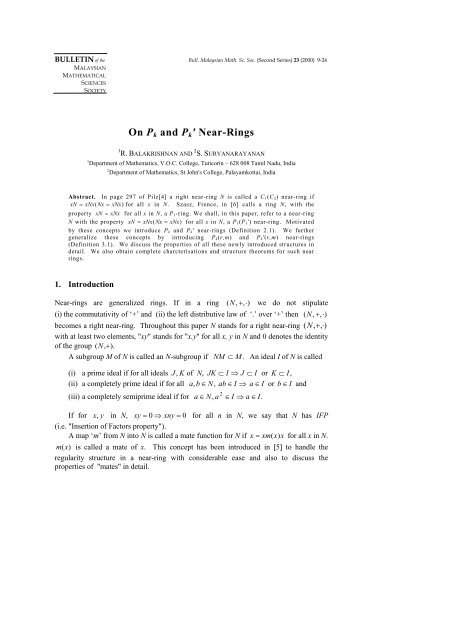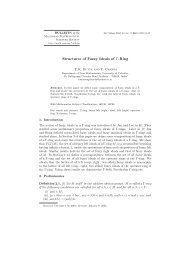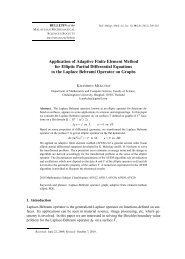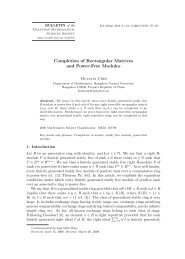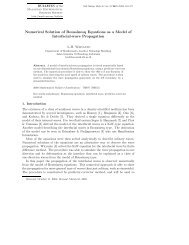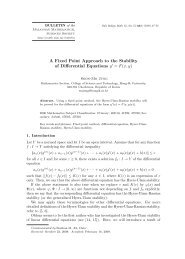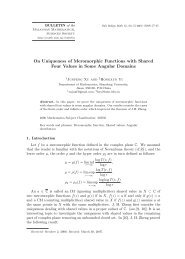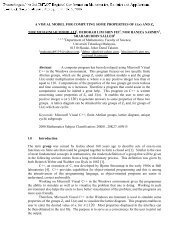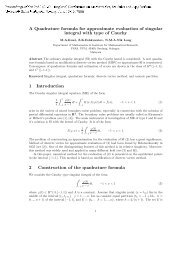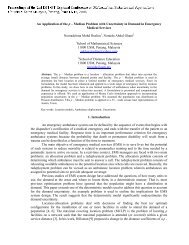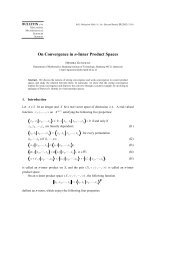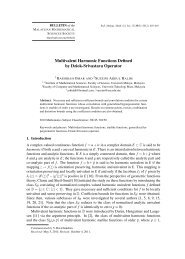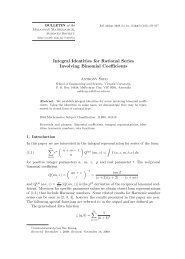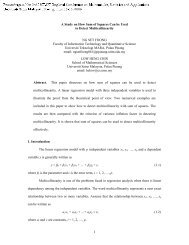On Pk and Pk' Near-Rings - European Mathematical Society
On Pk and Pk' Near-Rings - European Mathematical Society
On Pk and Pk' Near-Rings - European Mathematical Society
Create successful ePaper yourself
Turn your PDF publications into a flip-book with our unique Google optimized e-Paper software.
BULLETIN of the Bull. Malaysian Math. Sc. Soc. (Second Series) 23 (2000) 9-24<br />
MALAYSIAN<br />
MATHEMATICAL<br />
SCIENCES<br />
SOCIETY<br />
<strong>On</strong> <strong>Pk</strong> <strong>and</strong> <strong>Pk</strong>' <strong>Near</strong>-<strong>Rings</strong><br />
1 R. BALAKRISHNAN AND 2 S. SURYANARAYANAN<br />
1 Department of Mathematics, V.O.C. College, Tuticorin – 628 008 Tamil Nadu, India<br />
2 Department of Mathematics, St John's College, Palayamkottai, India<br />
Abstract. In page 297 of Pilz[4] a right near-ring N is called a C1(C2) near-ring if<br />
xN = xNx(<br />
Nx = xNx)<br />
for all x in N. Szasz, Frence, in [6] calls a ring N, with the<br />
property xN = xNx for all x in N, a P1-ring. We shall, in this paper, refer to a near-ring<br />
N with the property xN = xNx(<br />
Nx = xNx)<br />
for all x in N, a P1(P1') near-ring. Motivated<br />
by these concepts we introduce <strong>Pk</strong> <strong>and</strong> <strong>Pk</strong>' near-rings (Definition 2.1). We further<br />
generalize these concepts by introducing <strong>Pk</strong>(r,m) <strong>and</strong> <strong>Pk</strong>'(r,m) near-rings<br />
(Definition 3.1). We discuss the properties of all these newly introduced structures in<br />
detail. We also obtain complete charcterisations <strong>and</strong> structure theorems for such near<br />
rings.<br />
1. Introduction<br />
<strong>Near</strong>-rings are generalized rings. If in a ring ( N , + , ⋅)<br />
we do not stipulate<br />
(i) the commutativity of ‘+’ <strong>and</strong> (ii) the left distributive law of ‘.’ over ‘+’ then ( N , + , ⋅)<br />
becomes a right near-ring. Throughout this paper N st<strong>and</strong>s for a right near-ring ( N , + , ⋅)<br />
with at least two elements, "xy" st<strong>and</strong>s for "x.y" for all x, y in N <strong>and</strong> 0 denotes the identity<br />
of the group ( N , + ).<br />
A subgroup M of N is called an N-subgroup if NM ⊂ M.<br />
An ideal I of N is called<br />
(i) a prime ideal if for all ideals J, K of N, JK ⊂ I ⇒ J ⊂ I or K ⊂ I,<br />
(ii) a completely prime ideal if for all a, b ∈ N,<br />
ab ∈ I ⇒ a ∈ I or b ∈ I <strong>and</strong><br />
2<br />
(iii) a completely semiprime ideal if for a ∈ N,<br />
a ∈ I ⇒ a ∈ I.<br />
If for x, y in N, xy = 0 ⇒ xny = 0 for all n in N, we say that N has IFP<br />
(i.e. "Insertion of Factors property").<br />
A map ‘m’ from N into N is called a mate function for N if x = xm(<br />
x)<br />
x for all x in N.<br />
m (x)<br />
is called a mate of x. This concept has been introduced in [5] to h<strong>and</strong>le the<br />
regularity structure in a near-ring with considerable ease <strong>and</strong> also to discuss the<br />
properties of "mates" in detail.
10<br />
R. Balakrishnan <strong>and</strong> S. Suryanarayanan<br />
All the near-fields in this paper are zero-symmetric. Basic concepts <strong>and</strong> terms used<br />
but left undefined in this paper can be found in Pilz [4].<br />
1.1. Notations<br />
(i) E denotes the set of all idempotents of N.<br />
(ii) L is the set of all nilpotent elements of N.<br />
(iii) N d = { n ∈ N / n(<br />
x + y)<br />
= nx + ny for all x, y in N} the set of all distributive<br />
elements of N.<br />
(iv) N 0 = { n ∈ N / n0<br />
= 0}<br />
- the zero-symmetric part of N. (N is called zero-symmetric<br />
if N = N 0 ).<br />
(v) If S is a non-empty subset of N, C ( S)<br />
= { n ∈ N / nx = xn for all x ∈ S}<br />
(vi)<br />
<strong>and</strong> for C ({x}),<br />
we write C (x)<br />
for x in N.<br />
If N has IFP <strong>and</strong> if xy = 0 ⇒ yx = 0 (for x, y in N) then we say that N has<br />
(*, IFP).<br />
r m<br />
(vii) As in [1], N is a P ( r,<br />
m)<br />
near-ring if x N = Nx for all x in N where<br />
r, m are positive integers.<br />
1.2. Preliminary results<br />
We freely make use of the following results from [1], [2], [3], [4] <strong>and</strong> [5] <strong>and</strong> designate<br />
them as K(1), K(2) etc. (K for "Known Result").<br />
K(1) : When N admits mate functions the following are equivalent<br />
(i) N is P(1,2)<br />
(ii) E ⊂ C(N<br />
)<br />
(iii) N is P(2,1) (Theorem 2.20 of [1]).<br />
K(2) : When N admits mate funtions, N is a P ( r,<br />
m)<br />
near-ring (for all positive integers<br />
r, m ) if <strong>and</strong> only if N is a P ( 1,<br />
2)<br />
near-ring (Theorem 2.22 of [1]).<br />
K(3) : If N is a P( r,<br />
m)<br />
near-ring with a mate function, we have from K(2), the<br />
following results:<br />
(a) The concepts of N-subgroups, left ideals, right ideals <strong>and</strong> ideals are<br />
equivalent in N (Remark 2.26 (a) of [1]).<br />
(b) NaNb = Na ∩ Nb = Nab for all a, b in N (Proposition 2.32 of [1]).<br />
(c) N is subdirectly irreduible if <strong>and</strong> only if it is a near-field<br />
(Theorem 3.1 of [1]).<br />
(d) N is isomorphic to a subdirect product of near-fields (Theorem 3.3 of [1]).<br />
2<br />
K(4) : A near-ring N has no non-zero nilpotent elements if <strong>and</strong> only if x = 0 ⇒ x = 0<br />
for all x in N. (This result in prob 14, P.9 of [3] in respect of rings is valid for N<br />
as well).<br />
K(5) : A zero-symmetric near-ring N has IFP if <strong>and</strong> only if (0: S) is an ideal where S is<br />
any non-empty subset of N (9.3, p.289 of [4]).
<strong>On</strong> <strong>Pk</strong> <strong>and</strong> <strong>Pk</strong> ’ <strong>Near</strong> <strong>Rings</strong> 11<br />
K(6) : N is subdirectly irreducible if <strong>and</strong> only if the intersection of any family of nonzero<br />
ideals of N is again non-zero (1.60(c), p.25 of [4] <strong>and</strong> [2]).<br />
K(7) : If N admits mate functions <strong>and</strong> is subdirectly irreducible then it has no non-zero<br />
idempotent zero-divisors (vide stage (2) of the proof of Theorem 3.1<br />
of [1]).<br />
K(8) : If N admits a mate function m, then xm( x),<br />
m(<br />
x)<br />
x ∈ E <strong>and</strong> Nx = Nm(<br />
x)<br />
x <strong>and</strong><br />
xN = xm(<br />
x)<br />
N for all x in N (Lemma 3.2 of [5]).<br />
2<br />
K(9) : Let a = ba<br />
2<br />
<strong>and</strong> b = ab<br />
for a, b in N. Let u 1 = a − b,<br />
u2<br />
= au1<br />
<strong>and</strong><br />
u 3 = bu1.<br />
If there exist x i 's<br />
in N such that ui = xi<br />
ui<br />
( i = 1,<br />
2,<br />
3)<br />
then a = b<br />
(Lemma 2.5 of [5]).<br />
2. <strong>Pk</strong> <strong>and</strong> <strong>Pk</strong>' near-rings<br />
Definition 2.1. A near-ring N is called a <strong>Pk</strong> near-ring (<strong>Pk</strong>' near-ring) if there exists a<br />
k<br />
k<br />
positive integer k such that x N = xNx(<br />
Nx = xNx)<br />
for all x in N.<br />
Remark 2.2. Obviously any P k ' near-ring is zero-symmetric.<br />
Examples 2.3.<br />
(a) The direct product of any two near-fields is a P k as well as a P k ' near-ring.<br />
(b) The near-ring ( N, + , ⋅)<br />
where ( N, + ) is the Klein's four group with N = { 0,<br />
a,<br />
b,<br />
c}<br />
<strong>and</strong><br />
‘.’ satisfies the following table (scheme 12, p.408 of Pilz[4]).<br />
is a P k as well as a P k ' near-ring.<br />
. 0 a b c<br />
0 0 0 0 0<br />
a 0 a 0 a<br />
b 0 0 0 0<br />
c 0 a 0 a<br />
(c) Suppose in the example (b) above we define ‘.’ (as per scheme 8, p. 408 of Pilz[4])<br />
as follows<br />
. 0 a b c<br />
0 0 0 0 0<br />
a 0 0 0 a<br />
b 0 a b b<br />
c 0 a b c<br />
2
12<br />
R. Balakrishnan <strong>and</strong> S. Suryanarayanan<br />
Then ( N, + , ⋅)<br />
is a P k ' near ring but not a P k near ring for any k > 1.<br />
It is neither a<br />
P near-ring nor a P ' near-ring.<br />
1<br />
1<br />
(d) Consider the near-ring ( Z 4 , + , ⋅)<br />
where ( Z 4 , + ) is the group of integers modulo 4 <strong>and</strong><br />
‘.’ is defined as per scheme 2, p.407 of Pilz [4].<br />
. 0 1 2 3<br />
0 0 0 0 0<br />
1 0 1 0 0<br />
2 0 2 0 0<br />
3 0 3 0 0<br />
This is a P k near-ring for k > 1.<br />
It is not a P k ' near-ring for any positive integer k.<br />
(e) Any constant near-ring (i.e. ab = a for all a, b ∈ N ) is a P k near-ring.<br />
It is easy to verify the following:<br />
Proposition 2.4. Any homomorphic image of a P k ( <strong>Pk</strong><br />
' ) near-ring is a P k ( <strong>Pk</strong><br />
' )<br />
near-ring.<br />
As an immediate consequence of Proposition 2.4 we have the following:<br />
Theorem 2.5. Every P k ( <strong>Pk</strong><br />
' ) near-ring N is isomorphic to a subdiret product of<br />
subdirectly irreducible P k ( <strong>Pk</strong><br />
' ) near-rings.<br />
Proof. By 1.62, p.26 of Pilz[4], N is isomorphic to a subdirect product of subdirectly<br />
irreducible near-rings Ni`s, say, <strong>and</strong> each N i is a homomorphic image of N under the<br />
usual projection map π i . The desired result now follows from Proposition 2.4.<br />
Before proceeding further we have the following:<br />
r ∈<br />
Definition 2.6. We say that a near-ring N is an S r ( S r ' ) near-ring if x ∈ Nx ( x x N)<br />
for all x in N. When r = 1 we write “ S(S ')<br />
near-ring” instead of “ S ' ) near-ring”.<br />
Examples 2.7. Let r be any positive integer.<br />
1( S1<br />
(i) The near-ring of example 2.3(a) is an S r as well as an S r ' near-ring.<br />
(ii) Trivially any Boolean near-ring is an S r as well as an S r ' near-ring.<br />
(iii) The near-ring of example 2.3(e) is an S r ' near-ring (but it is not an S r<br />
near-ring).<br />
r
<strong>On</strong> <strong>Pk</strong> <strong>and</strong> <strong>Pk</strong> ’ <strong>Near</strong> <strong>Rings</strong> 13<br />
(iv) Let N be an arbitrary near-ring <strong>and</strong> let I be the ideal generated by<br />
r<br />
{ x − nx / n,<br />
x ∈ N}<br />
. Then N = N / I is an S r near-ring.<br />
(v)<br />
r<br />
If in example (iv), I is the ideal generated by { { x − x n / x,<br />
n ∈ N}<br />
then<br />
N = N / I is an S ' near-ring.<br />
r<br />
Remark 2.8. Examples 2.7(iv) <strong>and</strong> 2.7(v) provide devices for manufacturing S r <strong>and</strong><br />
S r ' near-rings from an arbitrary near-ring.<br />
Proposition 2.9. Every S r ( S r ' ) near-ring is an S (S'<br />
) near-ring.<br />
Proof. Let N be an S r ( S r ' ) near-ring with r ≥ 2.<br />
Clearly then for all<br />
r<br />
r−1<br />
x ∈ N,<br />
x ∈ Nx = ( Nx ) x ⊂ Nx(<br />
x ∈ x N = x(<br />
x N = x(<br />
x N)<br />
⊂ xN)<br />
S (S'<br />
) near-ring.<br />
r<br />
r−1<br />
r−1<br />
∴ N is an<br />
Remark 2.10. The converse of Proposition 2.9 is not valid. Obviously the near-ring of<br />
example 2.3 (c) is an S as well as an S' near-ring. But it is neither an S r near-ring nor an<br />
S r ' near-ring for r > 1.<br />
Also the (near -) ring of integers ( Z, + , ⋅)<br />
is an S as well as an S ' near-ring. But it is<br />
neither an S r near-ring nor an S r ' near-ring for r > 1.<br />
Thus even in the case of rings,<br />
the converse of Proposition 2.9 is not valid, in general.<br />
Before discussing the proporties of P k ( <strong>Pk</strong><br />
' ) near-rings we have the following:<br />
Lemma 2.11. Let N be a P 1 near-ring - ie xN = xNx for all x in N - with a mate<br />
function. Then N admits a mate function f such that f ( x)<br />
∈ C(<br />
x).<br />
Proof . Let m be a mate function for N. For x , m(<br />
x)<br />
in N, we can find a ‘t’ in N such<br />
2 2<br />
that xm ( x)<br />
= xtx (as xN = xNx ) i.e. x = xm(<br />
x)<br />
x = xtx = x'<br />
x with x ' = xt.<br />
We shall<br />
define f : N → N such that f ( x)<br />
= x'.<br />
Clearly then if we set y = xf ( x)<br />
x,<br />
it follows<br />
2<br />
2<br />
that xy = y <strong>and</strong> yx = x <strong>and</strong> K(9) guarantees x = y.<br />
Thus x = xf ( x)<br />
x <strong>and</strong> therefore f<br />
is a mate function for N.<br />
Again let us set a = xf ( x),<br />
b = f ( x)<br />
x,<br />
a − b = w1<br />
, xw1<br />
= w2<br />
<strong>and</strong> aw 1 = w3.<br />
By a<br />
slight modification of the proof of the Lemma 2.5 (K(9)) of [5], we get a = b <strong>and</strong> the<br />
desired result follows.<br />
Proposition 2.12. Let N be a P k or a P k ' near-ring. If N admits mate functions then<br />
L<br />
= { 0}.
14<br />
R. Balakrishnan <strong>and</strong> S. Suryanarayanan<br />
Proof. Suppose N is a P k near-ring with a mate function ‘m’.<br />
Case (i). k = 1 i.e. xN = xNx for all x in N. We appeal to Lemma 2.11 <strong>and</strong> observe<br />
that N admits a mate function f such that f ( x)<br />
∈ C(<br />
x)<br />
for all x in N. Therefore for all x<br />
2<br />
in N, we have x = xf ( x)<br />
x = x(<br />
xf ( x))<br />
= x f ( x)<br />
<strong>and</strong> this guarantees " 0 0"<br />
2<br />
x =<br />
From K(4) we get L = { 0}.<br />
⇒ x = .<br />
Case 2. Let k > 1.<br />
Now N = xNx for all x in N. Since x = xm(<br />
x)<br />
x ∈ xNx(<br />
= x N)<br />
we get<br />
k<br />
x = x n for some n in N. If k = 2 then<br />
2<br />
x = x n <strong>and</strong> therefore<br />
" 2<br />
x k<br />
x = 0 ⇒ x = 0".<br />
If k > 2 we have x = x ( x n)<br />
<strong>and</strong> again we get<br />
x = 0 ⇒ x = 0".<br />
This yields L = { 0}<br />
for all k > 1.<br />
In view of Remark 2.2 we can prove the above result when N is a P k ' near-ring, with<br />
k > 1,<br />
in a similar fashion. When k = 1 we observe that for x ∈ N,<br />
xNx = Nx.<br />
2<br />
2<br />
Consequently for all x in N, x = xm(<br />
x)<br />
x ∈ xNx = x(<br />
Nx)<br />
= x(<br />
xNx)<br />
= x Nx i.e. x ∈ x Nx.<br />
Hence " 0 0"<br />
2<br />
x = ⇒ x = <strong>and</strong> the proof is complete.<br />
" 2<br />
Remark 2.13. The converse of Proposition 2.12 is not valid. Examples are plentiful to<br />
justify this. To cite two such we have the following:<br />
(i) Consider the near-ring constructed on the Klein's four group as per scheme (21) p.<br />
408 of Pilz[4].<br />
2<br />
k −2<br />
. 0 a b c<br />
0 0 0 0 0<br />
a a a a a<br />
b 0 0 b 0<br />
c a a c a<br />
It is a <strong>Pk</strong> ( k ≥ 2)<br />
near-ring without nilpotent elements. But it has no mate<br />
function.<br />
(ii) Even in the case of rings, the converse does not hold. The ring ( Z , + , ⋅)<br />
of integers<br />
which is a P 2 as well as a P 2 ' near-ring comes in h<strong>and</strong>y to justify this. The<br />
following result will be made use of throughout this paper.<br />
Proposition 2.14. A P k ( <strong>Pk</strong><br />
' ) near-ring N has a mate function if <strong>and</strong> only if N is an<br />
S k '( S k ) near-ring.<br />
Proof. Let N be a P k near-ring with a mate function ‘m’. Therefore N = xNx for all<br />
k<br />
k<br />
x in N. Now x = xm(<br />
x)<br />
x ∈ xNx(<br />
= x N)<br />
<strong>and</strong> this implies x ∈ x N i.e. N is an S k '<br />
near-ring.<br />
x k<br />
k
<strong>On</strong> <strong>Pk</strong> <strong>and</strong> <strong>Pk</strong> ’ <strong>Near</strong> <strong>Rings</strong> 15<br />
Conversely let N be an S k ' −<strong>Pk</strong><br />
near-ring. ∴ x ∈ x N(<br />
= xNx)<br />
for all x in N.<br />
This implies x = xnx for some n in N. Therefore x = xm(<br />
x)<br />
x where we set<br />
m ( x)<br />
= n . Hence ‘m’ is a mate function for N.<br />
The proof in respect of P k ' near-rings is similar.<br />
Lemma 2.15. Let N be a zero-symmetric near-ring with a mate function `m'. Then<br />
(i) N has (*, IFP) if <strong>and</strong> only if L = { 0}.<br />
(ii) ene = en for all e ∈ E <strong>and</strong> n ∈ N.<br />
Proof.<br />
2<br />
(i) Suppose N has (*, IFP). If = 0<br />
k<br />
a for any a in N then by IFP, am ( a)<br />
a = 0.<br />
i.e.<br />
a = 0.<br />
Hence L = { 0}<br />
(by K(4)).<br />
Conversely if L = { 0},<br />
then<br />
2<br />
xy = 0 ⇒ ( 1)<br />
( yx)<br />
= ( yx)(<br />
yx)<br />
= y ( xy)<br />
x<br />
= y0x<br />
= y 0 = 0 ⇒ yx = 0 <strong>and</strong> (2) ( xny ) = ( xny)(<br />
xny)<br />
= xn ( yx)<br />
ny = xn0<br />
= 0 ⇒ xny = 0 for all n in N. Thus N has (*, IFP).<br />
(ii) For e ∈ E <strong>and</strong> n ∈ N we have ( ene − en)<br />
e = 0 <strong>and</strong> by (*, IFP), we get<br />
e( ene − en)<br />
= 0,<br />
en ( ene − en)<br />
= 0 <strong>and</strong> ene ( ene − en)<br />
= 0.<br />
These dem<strong>and</strong><br />
2 =<br />
( ene − en)<br />
0 <strong>and</strong> therefore ene = en since L = { 0}.<br />
As an immediate consequence of Lemma 2.15 - read with Propositions 2.12 <strong>and</strong> 2.14<br />
- we have the following:<br />
Corollary 2.16.<br />
(i) If N is an S k − <strong>Pk</strong><br />
' near-ring then N has (*, IFP).<br />
(ii) If N = N ) S ' − P near-ring then N has (*, IFP).<br />
= ( 0 is an k k<br />
Theorem 2.17. Let N be a near-ring with a mate function f. Then the following<br />
statements are equivalent:<br />
(i) N is P k ' for any positive integer k.<br />
(ii) E ⊂ C(N<br />
).<br />
(iii) N is P ( r,<br />
m)<br />
for all positive integers r<br />
, m.<br />
2
16<br />
Proof.<br />
R. Balakrishnan <strong>and</strong> S. Suryanarayanan<br />
(i) ⇒ (ii): Since Nx xNx<br />
k = for all x in N, Ne = eNe for all e in E. ∴ For any<br />
n ∈ N,<br />
there exists u ∈ N such that ne = eue.<br />
This implies ene = ( eue = ) ne.<br />
By Lemma 2.15 <strong>and</strong> Corollary 2.16(i) we have en = ene.<br />
Thus we get<br />
en = ( ene = ) ne <strong>and</strong> (ii) follows.<br />
(ii) ⇒ (i): Case 1 : Let k = 1.<br />
For all x in N, Nx = Nxf ( x)<br />
x = ( xf ( x)<br />
N)<br />
x = xNx<br />
(using K(8)) ∴ N is a P 1'<br />
near-ring.<br />
Case 2. Let k > 1.<br />
For all n, x in N,<br />
= xf ( x)(<br />
nx)<br />
x<br />
k −1<br />
= ( xf ( x)<br />
nx<br />
k −1<br />
2<br />
) x ∈ xNx.<br />
nx<br />
k<br />
= ( nx)<br />
x<br />
k − 1<br />
=<br />
n(<br />
xf ( x)<br />
x)<br />
x<br />
k −1<br />
Therefore Nx xNx.<br />
k ⊂ Also<br />
xnx = ( xf ( x)<br />
x)<br />
nx = xnf ( x)<br />
x = xnf ( x)<br />
x = ( xf ( x)<br />
x)<br />
nf ( x)<br />
x = xn(<br />
f ( x))<br />
.<br />
k − 1 k k<br />
Repeating this process we ultimately obtain xnx = ( xn(<br />
f ( x))<br />
) x ∈ Nx<br />
k<br />
k<br />
for all positive integers k. Therefore xNx ⊂ Nx . Thus xNx ⊂ Nx for all<br />
x in N <strong>and</strong> (i) follows.<br />
"(ii) ⇔ (iii)" follows from K(1) <strong>and</strong> K(2).<br />
2<br />
2<br />
2 3<br />
x<br />
Theorem 2.18. Any N-subgroup of an S k − <strong>Pk</strong><br />
' near-ring N is also an S k − <strong>Pk</strong><br />
'<br />
near-ring in its own right.<br />
Proof. Let N be an S k − <strong>Pk</strong><br />
' near-ring. Proposition 2.14 guarantees the existence of a<br />
mate function ‘f’ for N. Let M be any N-subgroup of N. From Theorem 2.17 we see that<br />
N is a P ( r,<br />
m)<br />
near-ring also. K(3)(a) dem<strong>and</strong>s that M is a right ideal of N. Therefore<br />
f ( x)<br />
xf ( x)<br />
∈ NMN ⊂ M for all x in M. Thus we can define a map g: M → M such that<br />
g ( x)<br />
= f ( x)<br />
xf ( x)<br />
for all x ⊂ M.<br />
Obviously g serves as a mate function for M - as<br />
xg ( x)<br />
x = x.<br />
Now let x, s ∈ M.<br />
Since Nx xNx<br />
k = there exists n ∈ N such that<br />
sx k<br />
= xnx = x(<br />
nxg(<br />
x))<br />
x ∈ x(<br />
NM ) x ⊂ xMx.<br />
∴ Mx xMx.<br />
k ⊂ Also since<br />
k<br />
xsx ∈ xNx(<br />
= Nx ) there exists n ∈ N<br />
xsx xg(<br />
x)<br />
( xsx)<br />
=<br />
k<br />
k<br />
xg(<br />
x)<br />
n1x<br />
= s1<br />
k<br />
k<br />
1 such that n1x<br />
.<br />
xsx = Again<br />
= x where s1 = xg(<br />
x)<br />
n1<br />
∈ MN ⊂ M.<br />
∴ xMx ⊂ Mx . Thus Mx xMx<br />
k = for all x ∈ M i.e. M is a P k ' near-ring. Since M<br />
has a mate function ‘g’, M is an S k near-ring as well (from Proposition 2.14).<br />
Corollary 2.19. Any N-homomorphic image of an S k − <strong>Pk</strong><br />
' near-ring N is an S k − <strong>Pk</strong><br />
'<br />
near-ring.
<strong>On</strong> <strong>Pk</strong> <strong>and</strong> <strong>Pk</strong> ’ <strong>Near</strong> <strong>Rings</strong> 17<br />
Proof. Let h : N → N be an N-homomorphism. Obviously h(N) is a subgroup of N.<br />
For n, n′ ∈ N,<br />
nh(<br />
n′<br />
) = h(<br />
nn′<br />
) ∈ h(<br />
N)<br />
⇒ Nh(<br />
N)<br />
⊂ h(<br />
N)<br />
⇒ h(<br />
N)<br />
is an<br />
N-subgroup of N. The result now follows from Theorem 2.18.<br />
Theorem 2.20. Let N be a near-ring with a mate function ‘m’. If E ⊂ C(N<br />
) then N is<br />
a P k near-ring for all positve integers k.<br />
Proof. Suppose E ⊂ C(N<br />
). If x ∈ N then xN = x(<br />
m(<br />
x)<br />
xN)<br />
= x(<br />
Nm(<br />
x)<br />
x)<br />
= xNx<br />
(using K(8)). This proves the theorem for k = 1.<br />
For k > 1 <strong>and</strong> for any<br />
k<br />
k −1<br />
x ∈ N,<br />
x N = x(<br />
x N)<br />
⊂ xN = xNx (using the result for k = 1 ) i.e. x N xNx.<br />
k ⊂<br />
Also xNx = xNxm(<br />
x)<br />
x = x(<br />
Nxm(<br />
x))<br />
x = x(<br />
xm(<br />
x)<br />
N)<br />
x = x(<br />
xN)<br />
x (using K(8))<br />
2<br />
2<br />
3<br />
= x Nx = x(<br />
xNx)<br />
= x(<br />
x Nx)<br />
= x Nx <strong>and</strong> continuing in the same vein we ultimately get<br />
k<br />
k<br />
xNx = x Nx ⊂ x N where k is any positive integer. Hence xNx = x N for all x ∈ N<br />
<strong>and</strong> the result follows.<br />
Remark 2.21. The converse of Theorem 2.20 is not valid. For example let us consider<br />
the near-ring ( N, + , ⋅)<br />
where ( N , + ) is the Klein's four group with N = { 0,<br />
a,<br />
b,<br />
c}<br />
<strong>and</strong> ‘.’<br />
satisfies the following table (defined as per scheme 1, p.408 of Pilz [4]).<br />
. 0 a b c<br />
0 0 0 0 0<br />
a 0 a a a<br />
b 0 b b b<br />
c 0 c c c<br />
This is a P k near-ring for all positive integers k. In fact it is a Boolean near-ring <strong>and</strong><br />
identity function serves as a mate function. But E( = N)<br />
⊂/ C(<br />
N).<br />
Corollary 2.22. Let N be a near-ring admitting mate functions. Then N is a P k ' nearring<br />
for a fixed positive integer k if <strong>and</strong> only if it is a P r as well as a P r ' near-ring for<br />
all positive integers r.<br />
Proof. For the ‘only if ’ part we proceed as follows: We appeal to Theorems 2.17 <strong>and</strong><br />
2.20 <strong>and</strong> observe that N is <strong>Pk</strong> ' ⇒ E ⊂ C(<br />
N)<br />
⇒ N is P r as well as P r ' for all positive<br />
integers r.<br />
Proof of ‘if part’ is obvious.<br />
k
18<br />
R. Balakrishnan <strong>and</strong> S. Suryanarayanan<br />
Remark 2.23. It is worth-noting that a P k near-ring with a mate function need not<br />
necessarily be a P k ' near-ring. The example cited under Remark 2.21 comes in h<strong>and</strong>y to<br />
justify this. It is a P k near-ring, for all positive integers k, <strong>and</strong> it admits mate functions.<br />
But it is not a P k ' near-ring for any k.<br />
We shall now discuss the conditons under which a P k near ring becomes a P k '<br />
near-ring.<br />
Theorem 2.24. Let N be a zero-symmetric near-ring admitting mate functions. Then N<br />
is a P k near-ring with E ⊂ N d if <strong>and</strong> only if N is a P k ' near-ring.<br />
Proof. For the ‘only if’ part we note that as N = N o <strong>and</strong> N has a mate funciton, it has<br />
(*, IFP ) <strong>and</strong> L = { 0}<br />
(by Propositon 2.14 <strong>and</strong> Corollary 2.16(ii)). From Lemma 2.15<br />
we get ene = en for all e ∈ E <strong>and</strong> n ∈ N.<br />
Since E ⊂ N d , e ( ne − ene)<br />
= 0.<br />
This<br />
2<br />
ultimately yields ( ne − ene)<br />
= 0 <strong>and</strong> consequently ne = ene.<br />
Thus we get E ⊂ C(N<br />
).<br />
Theorem 2.17 now guarantees that N is a P k ' near-ring.<br />
For the ‘if part’ we observe that N is <strong>Pk</strong> '⇒ E ⊂ C(<br />
N)<br />
(from Theorem 2.17) ⇒ N is<br />
a P k near-ring (Theorem 2.20). Again E ⊂ C(<br />
N)<br />
⇒ E ⊂ N d <strong>and</strong> the result follows.<br />
As an immediate consequence of Theorems 2.17 <strong>and</strong> 2.24 we get:<br />
Corollary 2.25. The following statements are equivalent in a near-ring N with mate<br />
functions.<br />
(i), (ii), (iii) of Theorem 2.17 <strong>and</strong><br />
(iv) N is a zero-symmetric P k near-ring with E ⊂ N d .<br />
From Corollaries 2.22 <strong>and</strong> 2.25 we obtain the following:<br />
Proposition 2.26. Let N admit mate functions. Then N is a zerosymmetric P k near-ring<br />
(for a fixed k) with E ⊂ N d if <strong>and</strong> only if N is a r<br />
positive integers r.<br />
P as well as a P ' near-ring for all<br />
Theorem 2.27. Let N be a P k near-ring with a mate function. If N is zero-symmetric <strong>and</strong><br />
has a left identity 1 then N is a P r ' near-ring for any positive integer r.<br />
Proof. Since N is a zero-symmetric P k near-ring with a mate function it has ( ∗ , IFP)<br />
<strong>and</strong> L = { 0}<br />
(from proposition 2.14, Lemma 2.15(i) <strong>and</strong> Corollary 2.16(ii)). Again by<br />
Lemma 2.15 (ii), ene = en for all e ∈ E <strong>and</strong> n ∈ N.<br />
Also since ( 1−<br />
e ) e = 0 we get<br />
( 1−<br />
e ) ne = 0 for all n ∈ N.<br />
∴ ne = ene.<br />
Thus en = ene = ne for all n ∈ N <strong>and</strong> for all<br />
e ∈ E.<br />
Hence E ⊂ C(N<br />
) <strong>and</strong> Theorem 2.17 guarantees that N is a P r ' near-ring for all<br />
positive integers r.<br />
r
<strong>On</strong> <strong>Pk</strong> <strong>and</strong> <strong>Pk</strong> ’ <strong>Near</strong> <strong>Rings</strong> 19<br />
Proposition 2.28. A left identity of a P k near-ring is also a right identity.<br />
Proof. Let e be a left identity of N. ∴ x = ex for all x ∈ N.<br />
Now<br />
e N eNe eN eNe.<br />
k<br />
= ⇒ = Then there exists n ∈ N such that x = ex = ene <strong>and</strong> this<br />
2<br />
implies x = ne.<br />
Hence xe ( = ne ) = ne = x.<br />
Thus ‘e’ is a right identity as well.<br />
Remark 2.29. A right identity of a P k near-ring need not be a left identity. In the<br />
example given under Remark 2.21 a , b,<br />
c are right identities but none is a left identity.<br />
This very same example together with Remark 2.23 asserts that Theorem 2.27 fails if N<br />
has only a right identity.<br />
Proposition 2.30. Every ideal of an S k ' −<strong>Pk</strong><br />
near-ring is a completely semiprime ideal.<br />
Proof. Case (i) Let k = 1.<br />
Then N has a mate function <strong>and</strong> xN = xNx for all x ∈ N.<br />
From Lemma 2.11 we observe that N has a mate function f such that<br />
xf ( x)<br />
= f ( x)<br />
x for all x in N. Let I be any ideal of N. If a ∈ I<br />
2<br />
then<br />
2<br />
a = af ( a)<br />
a = a(<br />
af ( a))<br />
= a f ( a)<br />
∈ IN ⊂ I.<br />
i.e. a ∈ I <strong>and</strong> the result follows.<br />
Case (ii) Let k > 1.<br />
Since N is an S k ' − <strong>Pk</strong><br />
near-ring Proposition 2.14 guarantees that<br />
N has a mate function say ‘m’. For<br />
k<br />
a ∈ N,<br />
a = am(<br />
a)<br />
a ∈ aNa(<br />
= a N)<br />
<strong>and</strong> consequently there exists n ∈ N such that<br />
k<br />
a = a n.<br />
. When<br />
2<br />
2<br />
k = 2,<br />
a ∈ I ⇒ a = a n ∈ IN ⊂ I.<br />
i.e. a ∈ I.<br />
When k > 2 , a ∈ I<br />
2<br />
⇒ a = a ( a<br />
k −2<br />
n)<br />
∈ IN ⊂<br />
I<br />
i.e. a ∈ I <strong>and</strong> the desired result follows.<br />
Propositions 2.31. Any prime ideal of an S k − <strong>Pk</strong><br />
' near-ring is a completely prime<br />
ideal.<br />
Proof. Let N be an S k − <strong>Pk</strong><br />
' near-ring. Then N has a mate function, say f (Proposition<br />
2.14). Let P be a prime ideal of N <strong>and</strong> let ab ∈ P.<br />
∴ Nab ⊂ NP ⊂ P (from Theorem<br />
2.17 <strong>and</strong> K(3)(a)). Clearly then NaNb( = Nab)<br />
⊂ P (from K(3)(b)). Since Na <strong>and</strong> Nb are<br />
ideals in N <strong>and</strong> since P is prime, Na ⊂ P or Nb ⊂ P.<br />
Therefore ( a = ) af ( a)<br />
a ∈ P or<br />
( b = ) bf ( b)<br />
b ∈ P <strong>and</strong> the desired result follows.<br />
Proposition 2.32. Any prime ideal of an S − P ' near-ring N is a maximal ideal.<br />
k<br />
Proof. Let I be a prime ideal of N. Let J be an ideal of N such that J ≠ 1 <strong>and</strong> that<br />
I ⊂ J ⊂ N.<br />
We need only to show that J = N.<br />
Let x ∈ J − I.<br />
From proposition 2.14<br />
2<br />
we see that N has a mate function, say, ‘m’. For x ∈<br />
N,<br />
x = xm(<br />
x)<br />
x = m(<br />
x)<br />
x<br />
k<br />
2
20<br />
R. Balakrishnan <strong>and</strong> S. Suryanarayanan<br />
(Q E ⊂ C(N<br />
) from Theorem 2.17). Thus for all n ∈ N,<br />
2<br />
nx = nm(<br />
x)<br />
x <strong>and</strong> this implies<br />
( n − nm(<br />
x)<br />
x)<br />
x = 0.<br />
Since N has IFP (Corollary 2.16(i)) we get z ( n − nm(<br />
x)<br />
x)<br />
zx = 0 for<br />
all z ∈ N.<br />
Consequently N ( n − nm(<br />
x)<br />
x)<br />
Nx = { 0}.<br />
If we let y = n − nm(<br />
x)<br />
x then<br />
NyNx = { 0}<br />
⊂ I.<br />
Since I is prime <strong>and</strong> Nx, Ny are ideals in N (Theorem 2.17 <strong>and</strong> K(3)(a))<br />
we get Ny ⊂ I or Nx ⊂ I.<br />
If Nx ⊂ I then x( = xm(<br />
x)<br />
x)<br />
∈ I which is clearly a<br />
contradiction. If Ny ⊂ I then Ny ⊂ J <strong>and</strong> this dem<strong>and</strong>s y( = ym(<br />
y)<br />
y)<br />
∈ J.<br />
i.e. n − nm(<br />
x)<br />
x ∈ J.<br />
From Theorem 2.17 <strong>and</strong> K(3)(a) we get nm( x)<br />
x ∈ J <strong>and</strong> therefore<br />
n ∈ J forcing J = N.<br />
The desired result now follows.<br />
Propositon 2.33. If N is an S k − <strong>Pk</strong><br />
' near-ring then for any e ∈ E,<br />
N is the direct sum<br />
of ideals Ne <strong>and</strong> ( 0 : Ne ).<br />
Proof. By Peirce decomposition N = Ne ⊕ ( 0 : e)<br />
(Q every n ∈ N can be uniquely<br />
written as n = ne + ( −ne<br />
+ n)<br />
). Since N is an S k − <strong>Pk</strong><br />
' near-ring Theorem 2.17 <strong>and</strong><br />
K(3)(a) guarantee that Ne is an ideal of N. We shall show that ( 0 : e ) = ( 0 : Ne).<br />
If y ∈ ( 0 : e)<br />
then for all n ∈ N,<br />
yne = yen (Q E ⊂ C(N<br />
) from Theorem 2.17 as N is<br />
an S − P ' near-ring) = 0. ∴ y ∈ ( 0 : Ne)<br />
<strong>and</strong> hence ( 0 : e) ⊂ ( 0 : Ne).<br />
Now<br />
k<br />
k<br />
x ∈ ( 0 : Ne)<br />
⇒ xne = 0 for all n in N. In particular, xee = xe = 0.<br />
Thus xe = 0 or<br />
x ∈ ( 0 : e).<br />
Therefore ( 0 : Ne) ⊂ ( 0 : e).<br />
Thus ( 0 : e ) = ( 0 : Ne).<br />
Since N has IFP<br />
(Corollary 2.16(i)) K(5) dem<strong>and</strong>s that ( 0 : Ne ) is an ideal. Obviously<br />
( 0 : Ne ) ∩ Ne = { 0}<br />
<strong>and</strong> the desired result follows.<br />
Theorem 2.17 <strong>and</strong> K(3)(d) guarantee the following structure theorem for an S k − <strong>Pk</strong><br />
'<br />
near-ring :<br />
Theorem 2.34. An S k − <strong>Pk</strong><br />
' near-ring is isomorphic to a subdirect product of nearfields.<br />
We shall make use of the following result for obtaining a structure theorem for an<br />
S ' − P near-ring.<br />
k<br />
k<br />
Theorem 2.35. Let N be a zero-symmetric S k '<br />
irreducible if <strong>and</strong> only if N is simple.<br />
− <strong>Pk</strong><br />
near-ring. Then N is subdirectly<br />
Proof. Since N is an S k ' − <strong>Pk</strong><br />
near-ring it admits mate functions (Proposition 2.14).<br />
Suppose N is subdirectly irreducible. K(7) guarantees that no non-zero idempotent<br />
element of N is a zero-divisor <strong>and</strong> this dem<strong>and</strong>s Nx = N for all non-zero x in N. Hence<br />
N has no non-trivial N-subgroups. Since N = N o as well, all ideals are N-subgroups.<br />
Consequently N is simple.<br />
The converse is obvious from K(6).
<strong>On</strong> <strong>Pk</strong> <strong>and</strong> <strong>Pk</strong> ’ <strong>Near</strong> <strong>Rings</strong> 21<br />
As an immediate consequence of Theorem 2.35 we have the following:<br />
Theorem 2.36. If N is a zero-symmetric S k '<br />
subdirect product of simple near-rings.<br />
− <strong>Pk</strong><br />
near-ring then N is isomorphic to a<br />
Proof. From Theorem 2.5, N is isomorphic to a subdirect product of subdirectly<br />
irreducible P k near-rings, N i 's<br />
say. Since N has a mate function (Proposition 2.14) we<br />
see that each N i , being a homomorphic image of N, has a mate function. Theorem 2.35<br />
takes care of the rest of the proof.<br />
Corollary 2.37. If N is a zero-symmetric S k ' − <strong>Pk</strong><br />
near-ring <strong>and</strong> if every homomorphic<br />
image of N has at least one non-zero distributive element then N is isomorphic to a<br />
subdirect product of near-fields.<br />
Proof. This result is an immediate consequence of 8.3 of Pilz[4] <strong>and</strong> Theorem 2.36.<br />
Corollary 2.38. Let N be a zero-symmetric S k ' − <strong>Pk</strong><br />
near-ring with at least one nonzero<br />
distributive element. Then N is subdirectly irreducible if <strong>and</strong> only if N is a nearfield.<br />
Proof. The desired result follows from 8.3 of Pilz[4] <strong>and</strong> Theorem 2.35.<br />
Corollary 2.39. If N is a zero-symmetric S k ' − <strong>Pk</strong><br />
near-ring with E ⊂ N d then N is<br />
isomorphic to a subdirect product of near fields.<br />
Proof. Corollary 2.25 <strong>and</strong> Theorem 2.34 guarantee the desired result.<br />
Theorem 2.40. If a P k near-ring N fulfills the left cancellation law then N is a nearintegral<br />
domain.<br />
Proof. Let S be any subsemigroup of N <strong>and</strong> let n ∈ N.<br />
Since N = sNs for s ∈ S<br />
there exists n′ ∈ N such that s n sn<br />
s.<br />
k k<br />
= ′ i.e. s1 n = n1s<br />
where s1<br />
= s ∈ S <strong>and</strong><br />
n1 = sn′<br />
∈ N.<br />
i.e. S satisfies the left Ore condition. 9.60 of Pilz[4] guarantees that<br />
N is a near-integral domain.<br />
Corollary 2.41. If N, satisfying the conditions of Theorem 2.40, has DCCN then N is a<br />
near-field.<br />
Proof. This is an immediate consequence of 9.62(c) of Pilz [4] <strong>and</strong> Theorem 2.40.<br />
s k
22<br />
3. <strong>Pk</strong>(r,m) <strong>and</strong> <strong>Pk</strong>'(r,m) <strong>Near</strong>-<strong>Rings</strong><br />
R. Balakrishnan <strong>and</strong> S. Suryanarayanan<br />
In this section we shall introduce <strong>Pk</strong> ( r,<br />
m)<br />
<strong>and</strong> <strong>Pk</strong> ' ( r,<br />
m)<br />
near-rings by way of<br />
generalizing the concepts of P k <strong>and</strong> P k ' nearrings.<br />
Definition 3.1. A near-ring N is called a <strong>Pk</strong> ( r,<br />
m)<br />
( <strong>Pk</strong> '(<br />
r,<br />
m)<br />
) near-ring if there exist<br />
k r m k r m<br />
positive integers k , r,<br />
m such that for all x in N, x N = x Nx ( Nx = x Nx ).<br />
Remark 3.2. Obviously a <strong>Pk</strong> ' ( r,<br />
m)<br />
near-ring is zero-symmetric. A P k ( 1,<br />
1)<br />
( <strong>Pk</strong><br />
'(<br />
1,<br />
1)<br />
)<br />
near-ring is nothing but a <strong>Pk</strong> ( <strong>Pk</strong><br />
' ) near-ring.<br />
Examples 3.3. Let k , r,<br />
m be any three positive integers.<br />
(i) The direct product of any two near-fields is a <strong>Pk</strong> ( r,<br />
m)<br />
as well as a <strong>Pk</strong> ' ( r,<br />
m)<br />
near-ring.<br />
(ii) A constant near-ring is a <strong>Pk</strong> ( r,<br />
m)<br />
near-ring. It is not a <strong>Pk</strong> ' ( r,<br />
m)<br />
near-ring.<br />
(iii) <strong>Near</strong>-ring of example 2.3(b) is a <strong>Pk</strong> ( r,<br />
m)<br />
as well as a <strong>Pk</strong> ' ( r,<br />
m)<br />
near-ring.<br />
(iv) The near-ring given in example 2.3(c) is a <strong>Pk</strong> ' ( r,<br />
m)<br />
but not a <strong>Pk</strong> ( r,<br />
m)<br />
near-ring<br />
for k > 1.<br />
It is not P ( r,<br />
m)<br />
nor P '(<br />
r,<br />
m).<br />
1<br />
1<br />
Lemma 3.4. Let f be a mate function for N. If E ⊂ C(N<br />
) then<br />
r<br />
r<br />
r<br />
( xf ( x)<br />
= ) ( xf ( x))<br />
= x ( f ( x))<br />
for all x in N <strong>and</strong> for all positive integers r.<br />
Proof. As E ⊂ C(N<br />
) we have, ( xf ( x)<br />
= ) ( xf ( x))<br />
= xf ( x)<br />
( xf ( x))<br />
= x(<br />
xf ( x))<br />
f ( x)<br />
2<br />
2<br />
= x ( f ( x))<br />
. Continuing in the same vein we get ( xf ( x)<br />
= ) ( xf ( x))<br />
= x ( f ( x))<br />
for<br />
all positive integers r.<br />
Theorem 3.5. Let N admit a mate function ‘f'. Then N is a P k ' ( 1,<br />
1)<br />
near-ring for a fixed<br />
k if <strong>and</strong> only if N is a Pt ' ( r,<br />
m)<br />
<strong>and</strong> a Pt ( r,<br />
m)<br />
near-ring for all positive integers t, r, m.<br />
Proof. Suppose N is a <strong>Pk</strong> '(<br />
1,<br />
1)<br />
near-ring for a fixed positive integer k. Theorem 2.17<br />
dem<strong>and</strong>s that E ⊂ C(N<br />
). Let t , r,<br />
m be any three positive integers. For x ⊂ N,<br />
r<br />
m<br />
k<br />
x Nx ⊂ xNx = Nx ( Q N is P ' ( 1,<br />
1).<br />
∴ x Nx ⊂ Nx .<br />
1<br />
k =<br />
k<br />
Now let z ∈ Nx ( xNx).<br />
Then there exists y ∈ N such that z = xyx<br />
r<br />
= ( xf ( x))<br />
( xyx(<br />
f ( x)<br />
x)<br />
= ( xf ( x))<br />
( xyx(<br />
f ( x)<br />
x)<br />
as xf ( x),<br />
f ( x)<br />
x ∈ E.<br />
Since E ⊂<br />
C(N<br />
)<br />
m<br />
2<br />
r<br />
m<br />
k<br />
r<br />
r<br />
r
<strong>On</strong> <strong>Pk</strong> <strong>and</strong> <strong>Pk</strong> ’ <strong>Near</strong> <strong>Rings</strong> 23<br />
we can make use of Lemma 3.4 <strong>and</strong> get z = x (( f ( x))<br />
xyx(<br />
f ( x))<br />
) x ∈ x Nx .<br />
k<br />
Thus Nx<br />
r m<br />
⊂ x Nx<br />
2<br />
r<br />
m<br />
k<br />
Hence x Nx = Nx ( = xNx).<br />
From Corollary 2.22 we observe that N is a P t ( 1,<br />
1)<br />
as<br />
well as a P ' ( 1,<br />
1)<br />
near-ring for all positive integers t. Hence<br />
t<br />
t<br />
t<br />
k<br />
r<br />
m<br />
x N = Nx = xNx = Nx = x Nx for all x in N. i.e. N is a Pt ( r,<br />
m)<br />
as well as a<br />
Pt ' ( r,<br />
m)<br />
near-ring for all positive integers t , r,<br />
m.<br />
Converse is obvious.<br />
Theorem 3.6. Let N be a near-ring with a mate function. Then N is a zero-symmetric<br />
P k ( 1,<br />
1)<br />
near-ring with E ⊂ N d if <strong>and</strong> only if N is a Pt ( r,<br />
m)<br />
as well as a Pt ' ( r,<br />
m)<br />
near-ring for all positive integers t , r,<br />
m.<br />
Proof. N is zero-symmetric, P k ( 1,<br />
1)<br />
with E ⊂ N d ⇔ N is a P k ' ( 1,<br />
1)<br />
near-ring for<br />
any positive integer k(Corollary 2.25) ⇔ N is a Pt ( r,<br />
m)<br />
as well as a Pt ' ( r,<br />
m)<br />
near-ring<br />
for all positive integers t , r,<br />
m (Theorem 3.5).<br />
Collecting the pieces of results from Theorem 2.17, Corollaries 2.22, 2.25,<br />
Proposition 2.26 <strong>and</strong> Theorems 3.5 <strong>and</strong> 3.6 we obtain:<br />
Theorem 3.7. The following statements are equivalent in a near-ring N with mate<br />
functions.<br />
(1) N is a P k '( = <strong>Pk</strong><br />
'(<br />
1,<br />
1))<br />
near-ring for a fixed positive integer k.<br />
(2) N is a zero-symmetric P k ( = <strong>Pk</strong><br />
( 1,<br />
1))<br />
near-ring for a fixed positive integer k with<br />
E ⊆ N d .<br />
(3) N is a P ( r,<br />
m)<br />
near-ring for all positive integers r, m.<br />
(4) N is a Pt ' ( u,<br />
v)<br />
near-ring for all positive integer t, u, v.<br />
(5) N is a zero-symmetric Pt ( u,<br />
v)<br />
near-ring for all positive integers t, u, v<br />
with E ⊆ Nd.<br />
We conclude our discussion with the following:<br />
Remark 3.8. Theorem 3.7 - when read with K(3)(d) - guarantees that if N admits mate<br />
functions <strong>and</strong> is either a Pt ( u,<br />
v)<br />
near-ring with E ⊂ N d or simply a Pt ' ( u,<br />
v)<br />
near-ring<br />
- where t , u,<br />
v are any three positive integers - then N is isomorphic to a subdirect<br />
product of near-fields.<br />
r<br />
r<br />
m<br />
m<br />
r<br />
m
24<br />
References<br />
R. Balakrishnan <strong>and</strong> S. Suryanarayanan<br />
1. R. Balakrishnan <strong>and</strong> S. Suryanarayanan, P(r,m) <strong>Near</strong>-<strong>Rings</strong> - To appear in the Bull. Malaysian<br />
Math. Sc. Soc.<br />
2. Gratzer, George, Universal Algebra, Springer Verlag, New York, 1979.<br />
3. Neal.H. McCoy - The Theory of <strong>Rings</strong>, MacMillan & Co., 1970.<br />
4. Pilz Gunter, <strong>Near</strong> <strong>Rings</strong>, North Holl<strong>and</strong>, 1983.<br />
5. S. Suryanarayanan <strong>and</strong> N. Ganesan, Stable <strong>and</strong> Pseudostable near-rings, Indian J.Pure <strong>and</strong><br />
Appl. Math. 19 (December, 1988), 1206-1216.<br />
6. Szasz, Frence: Some generalizations of strongly regular rings - Mathematicae Japonicae 17<br />
(1972), 115-118.


